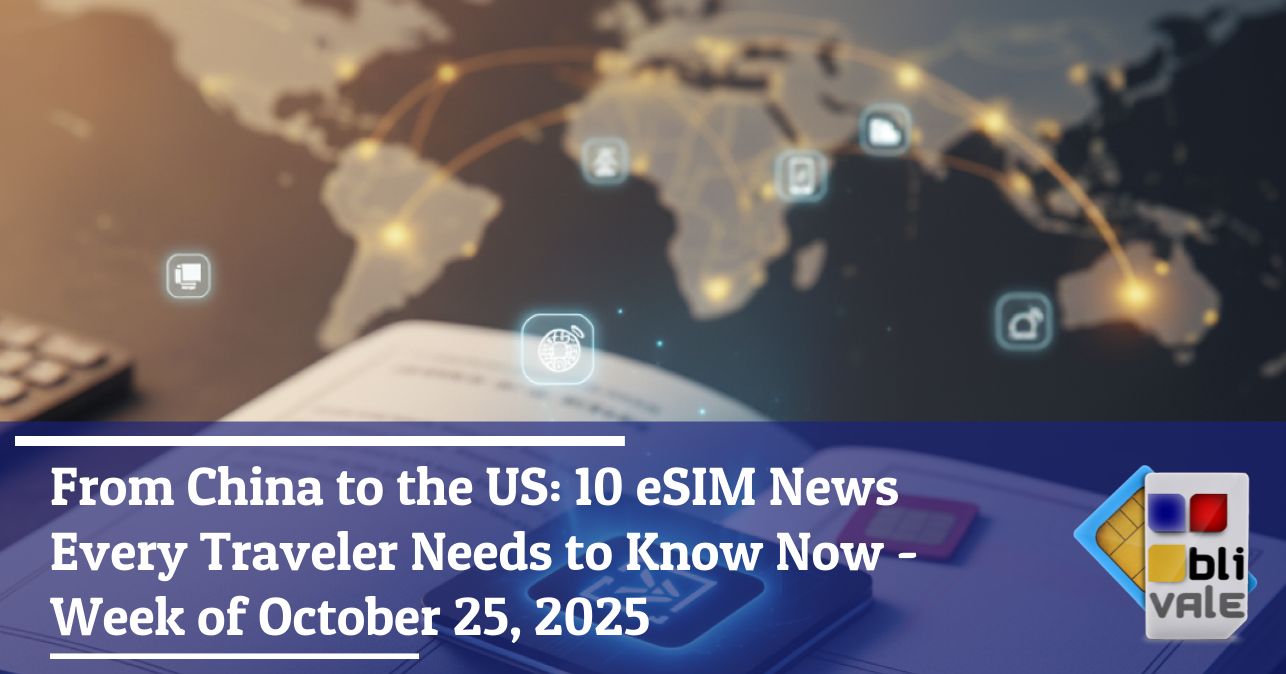Welcome to the Future of Connectivity
In an increasingly interconnected world, staying up-to-date on technological innovations is no longer a luxury, but a necessity. Whether you're a telecommunications professional, a frequent traveler, or simply a tech enthusiast, this week brought news that will change the way we think about mobile connectivity. From the explosion of the eSIM market for travelers to the quiet revolution of iSIMs in the IoT, we're witnessing a seismic shift that will make traditional physical SIMs a thing of the past.
The 10 Most Important News of the Week
1. Travel eSIM Market to Reach $1.8 Billion by 2025
The travel eSIM market is expected to reach $1.8 billion by the end of 2025, an impressive 85% increase from $989 million in 2024. This extraordinary growth is revolutionizing the international roaming industry, with eSIM providers directly challenging traditional services with Connectivity-as-a-Service platforms that break down technical barriers.
Analysts predict the market will exceed $8.7 billion by 2030, while travel eSIM adoption is growing nearly 50% year-over-year in key markets such as Malaysia, Singapore, South Korea, Australia, Brazil, and India.
Link: Travel eSIM Market Hits US$1.8bn in 2025
2. China Opens the Door to eSIM with the iPhone Air
Beijing approved "commercial trials" of the iPhone Air's eSIM feature by China's three major carriers—China Unicom, China Mobile, and China Telecom—last week, and the iPhone Air sold out within minutes of its release on Friday. This historic decision marks a turning point for the Chinese market, where eSIMs had been banned since 2023.
By October 15, more than 170,000 Unicom customers had pre-ordered eSIMs, demonstrating the enormous pent-up demand. Local manufacturers like Oppo and Huawei are also quickly following suit with their own compatible devices.
Link: How iPhone Air's eSIM debut reshapes China's telecoms landscape
3. Summer 2025: eSIMs Go Mainstream in Travel
By summer 2025, 19% of global travelers used an eSIM to stay connected, surpassing WiFi-only users (17.5%) and leaving portable WiFi devices behind (3.3%). Even more impressively, 95% of first-time users said they would use an eSIM again.
The research also revealed that among multi-country travellers, eSIM usage jumped to 26%, significantly higher than the global average of 19%.
Link: Beyond borders: Summer 2025 travel and eSIM report
4. Kigen Vince "IoT Solution of the Year" per la Tecnologia iSIM
Kigen, a global leader in eSIM security solutions and a pioneer of embedded SIM (iSIM), announced that its eIM solution has been named "IoT Solution of the Year" in the 2025 Mobile Breakthrough Awards. This recognition underscores the growing importance of iSIM technology in the IoT landscape.
The Kigen eIM solution is the first fully GSMA-accredited IoT eSIM Manager, aligned with the GSMA SGP.32 specification, and optimizes the entire eSIM lifecycle for cellular LPWAN IoT networks.
Link: Kigen Wins "IoT Solution of the Year" in 2025 Mobile Breakthrough Awards
5. AT&T Launches Standalone 5G Nationwide
AT&T has completed the nationwide deployment of its Standalone (SA) 5G network, marking a major leap into the future of wireless connectivity. Unlike "Non-Standalone" (NSA) 5G, which relied on 4G LTE infrastructure, Standalone 5G is a completely independent 5G core and radio network, designed specifically for the next generation of wireless.
This deployment unlocks advanced capabilities such as faster upload speeds, ultra-low latency, ultra-high reliability, and edge features.
If you are thinking of taking a trip alone or with friends or for work, do not forget the importance of staying connected wherever you are. For unlimited Internet connection, contact BLIVALE where you can get unlimited Internet according to the destinations:
For unlimited plans like data BLIVALE guarantees free roaming anywhere in the world, no additional or hidden costs. Don't let the lack of connection stop you; get ready to explore the world with freedom and spontaneity.
6. AT&T and Toyota: Partnership for the Future of Automotive Connectivity
Toyota Motor North America is revolutionizing the driving experience by introducing AT&T 5G connectivity to select 2026 model year Toyota vehicles. Advanced 5G connectivity will enable improved integrated audio streaming, reliable Wi-Fi hotspots, seamless real-time navigation, remote services, and over-the-air updates.
Passengers will be able to connect up to five WiFi-enabled devices at 5G speeds, ensuring high-speed internet access for streaming, browsing, gaming, or remote working.
Link: AT&T and Toyota Drive the Future of 5G Connectivity
7. iSIM: The Next Evolution in IoT Connectivity
The release of certified commercial embedded SIMs has ushered in a new era for the mass production of connected devices, with Qualcomm and Thales confirming the release of a GSMA-compliant iSIM for remote SIM provisioning.
Kaleido Intelligence research suggests that the iSIM market will grow to 300 million units by 2027, accounting for 19% of the market share of all eSIM shipments. iSIM technology integrates SIM functionality directly into the device's processor, eliminating the need for a physical SIM or soldered eSIM.
Link: iSIM opens a new world of opportunity for mobile and IoT innovation
8. eSIM Market Growth: Forecast 2025-2030
The eSIM market grew from $11.76 billion in 2023 to $13.54 billion in 2024, and is expected to continue growing at a CAGR of 15.27%, reaching $31.82 billion by 2030.
Growth is driven by growing demand for smart devices, IoT expansion, and the rise of mobile data subscriptions. Key opportunities lie in the expansion of IoT applications, particularly in automotive telematics, smart city infrastructure, and cross-border communications.
Link: eSIM Market Global Forecasts 2024-2025 & 2030
9. 5G FWA CPE Shipments to Grow 26% in 2025
5G Fixed Wireless Access (FWA) CPE shipments are expected to accelerate, growing 26% in 2025 to reach 35.3 million units. Globally, 5G FWA is increasingly becoming the norm, with over half the world reporting that over 50% of FWA CPE shipments in 2024 were 5G-enabled.
5G mmWave CPE shipments are expected to grow to over 1 million over the same period (up 47% year-over-year), while 41% of vendors plan to introduce a 5G RedCap-enabled FWA product in 2025.
Link: 5G FWA CPE Shipments Grow 26% in 2025
10. IoT SIM Cards as a Frontier of Cybersecurity
SIM technology is no longer just a connectivity channel: it is becoming the frontline for cybersecurity, device identity, and regulatory compliance. IoT SIMs are specifically designed for smart devices, offering greater flexibility, security, and scalability than traditional smartphone SIMs.
With the emergence of new technologies like AI, optimized IoT SIMs provide real-time data monitoring, remote device management, and usage analytics, increasing operational efficiency and protecting against malicious actions.
Link: Beyond Connectivity: How IoT SIMs Are Powering the Secure Future
Conclusion: The Future Is Without Physical SIM Cards
This week has clearly shown us that we are at a turning point in the history of telecommunications. The convergence of eSIMs, iSIMs, and advanced 5G networks is creating an unprecedented global connectivity ecosystem. The numbers speak for themselves: mass adoption has begun.
For travelers, this means saying goodbye to the frustrations of roaming charges and purchasing physical SIM cards in every country. For businesses, it means more secure, compact, and easily manageable IoT devices. For network operators, it means a necessary transformation to remain competitive in a rapidly evolving market.
The question is no longer "if" but "when" traditional physical SIM cards will become obsolete. And the answer, looking at this week's trends, is: very soon. The future of connectivity is digital, flexible, and global. And that future is already here.









